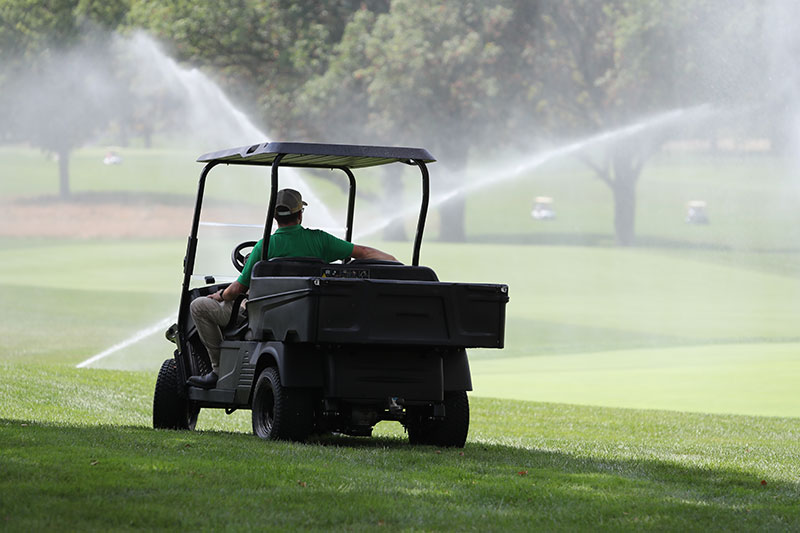
Managing a golf course & a fleet of golf carts? Read through our golf course manager’s guide to golf cart maintenance to keep your carts in prime condition.
by Jordan Fuller / golfinfluence.com
Golf carts are essential parts of a golf course. They may not be the first thing golfers think about on the course, but it’s definitely noticeable if they’re not there or if they aren’t working quite as they should!
This golf course manager’s guide to golf cart maintenance will give you a quick overview of what you should be doing to keep your golf carts in the best condition possible.
Whatever golf carts you have, they should come with a manual. We advise that you read through it and follow the manufacturer’s advice when it comes to maintaining your golf carts.
The below points may or may not feature in the user manual, but they’re important to keep your carts in prime condition. Ultimately, this benefits you financially, while keeping your patrons happy with well-rounded service.
Clean and Charge Batteries Regularly
You can’t risk a golf cart’s battery dying while your patrons are halfway through a round! Make sure you charge them between uses so that there’s never a chance of a problem while someone is on the course.
You should also clean your golf carts batteries regularly. Corrosion can build up quickly (depending on where in the world you are), and so can dust, dirt, and grime. Leaving this for too long can cause it to become hard and caked onto the battery terminals.
It’s a good idea to clean these at least once a month to ensure that there are no problems. If you can, every second week is a better time frame.
Fill Batteries With Water Regularly
Forgetting to top up the water in your golf cart batteries could have a detrimental effect on the quality of the battery. The lead plates inside the battery need to be completely submerged in order for them to work without hassle. It’s best to use distilled water and not just tap water. The chemicals in tap water could also have a damaging effect, so you should keep distilled water in stock for this purpose.
You should only have to do this once a month, but it’s wise to check it more often than that, depending on how often your golf carts are used.
Keep Your Tires Filled With Air
Riding on low-pressure tires can cause the tires to wear out quicker than they should. If there isn’t enough air pressure, the tread on the tires also can’t do its job properly.
Ensuring that the tires are at the correct air pressure will also make the ride smoother for your patrons, which will improve their all-round experience on the course.
We advise checking this on a weekly basis. You should be able to find the correct air pressure for your golf cart in the user manual.
Make Sure the Brakes Are Working
Although nobody should be driving at high speeds on a golf course, especially with an electric golf cart rather than a gas cart, it’s in the drivers’ best interest to make sure that the brakes are always in optimal condition.
If you notice any problem with the brakes on a golf cart, that cart should immediately be removed from use until the brakes have been examined and any problems have been fixed.
You should inspect every golf cart’s brakes at least once a year to make sure that they’re in prime condition. You can have a professional come in and check them for you if you aren’t sure what to look for, but this step shouldn’t be neglected!

Get Them Professionally Serviced Yearly
Even if you stick to these recommendations religiously and rigorously inspect, repair, and maintain your fleet of golf carts, it’s a great idea to have them professionally serviced at least once a year.
Sometimes things get missed, or perhaps jobs get done in a bit of a hurry. Maintaining a fleet of golf carts takes time and energy, and there’s not always enough of it to go around!
Having a professional service yearly will take care of any issues that may have been missed or a little neglected during the year. It will also be able to inspect and repair golf cart parts that you may not be able to inspect yourself.
You can set up a golf cart service schedule so you don’t have your whole fleet in for service at once. Or schedule them for servicing in two groups.
Have A Weight Limit
Check the user manual for the maximum load the golf cart can take. Try not to overload it and ensure that golfers stick to the weight limits as well.
Remember, golfers will have their own weight and that of their equipment on the cart. If the average cart weight limit can only accommodate two people with bags, then make sure that you send out an adequate number of carts per party; for example, 2 carts with a party of 4 golfers.
Remove Them From Being Used If There’s A Problem
If you notice any problem with a golf cart, remove them from use immediately until you can get the problem fixed. Allowing the golf cart to be driven while it’s not in top condition damages the cart and can also put your golfers at risk. Take the golf cart off rotation and prioritize finding the problem and fixing it. Once the golf cart has been repaired and is safe to drive again, you can make it available for use again.
Golf cart maintenance is an essential part of managing a golf course. Your course can be as beautiful as ever, gameplay can be amazing, and the steaks at the clubhouse restaurant can be delectable. But if your golf carts are out of order or give players trouble, that could be the one thing that gets you a bad review. Thankfully, it doesn’t take much to keep them running in the best possible condition. Spend some time on a daily basis cleaning them, and do your maintenance checks weekly or monthly, and they should last a good long time.
About the Author
Jordan Fuller has spent many hours on the golf course since he learned to play as a youngster. When he’s not playing, learning more about his favorite sport, or mentoring young golfers, he’s researching and writing helpful articles for his website, golfInfluence.com.










